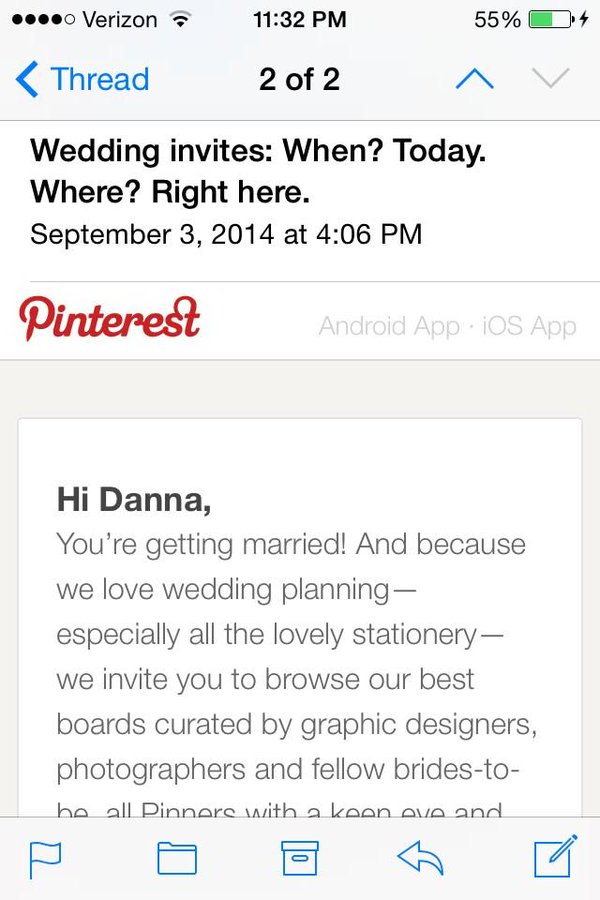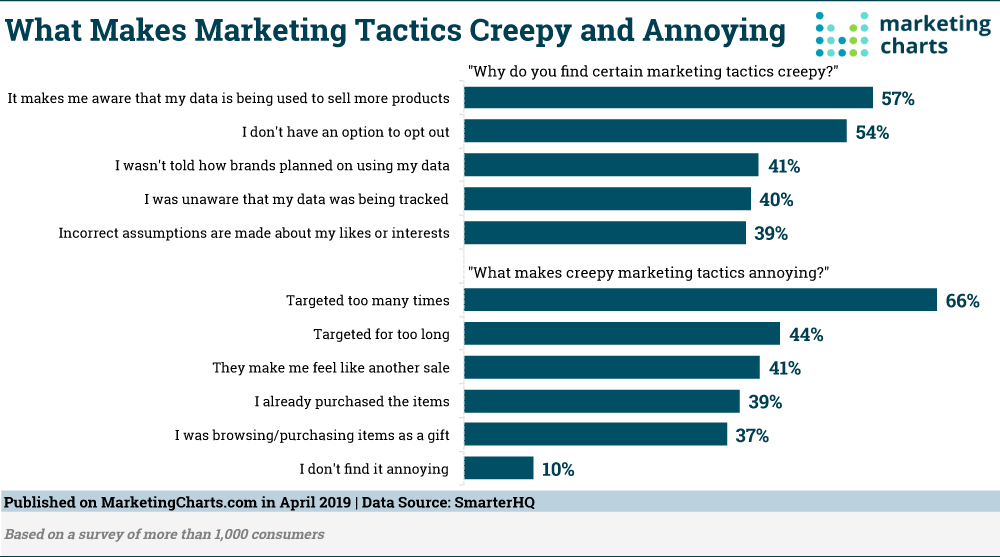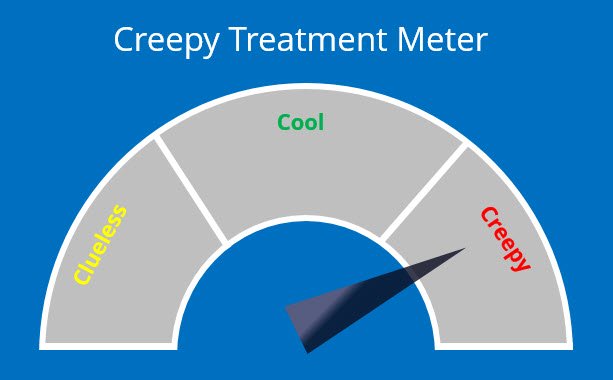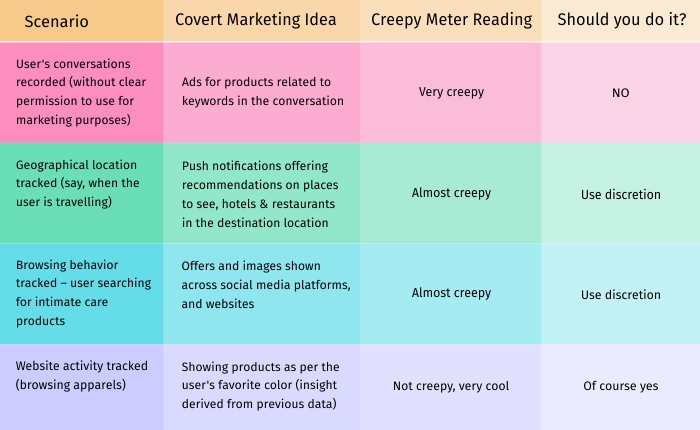One fine day (before COVID-19), I was chit-chatting with my girlfriends over coffee. The girl-talk covered quite a few subjects like best nail paint shades and great women intimate-wear brands.
After a while, when I opened Instagram app on my phone, I found my feed filled with ads by many of the brands we were talking about.
I was creeped out!
I hadn’t even searched for those brands on the internet, but ads popped up here and there, as if someone was secretly listening to my private conversations.
Would you call this marketing as good personalization or a bad one?
I say, its Creepy Personalization.
What is personalization in marketing?
Why is hyper-personalization crucial in today’s world?
Data points to prove and support that personalization is important.
Examples of brands that are soaring because of great personalization.
Examples of brands that are sinking because of not personalizing CX enough.
How can you incorporate personalization strategies in your marketing efforts?
I am certain that you have read a lot about all of it, practice it, and follow it. I am not going to write anything more about any of these. Here we have a great repository of Blogs on Personalization.
All personalization is good, isn’t it?
Personalization is good for the business. But how and when does it go wrong? When does personalization turn creepy?
And what exactly is creepy personalization?
Well, check these examples:
Netflix: You say personalization or personalized recommendations, and the brand that comes to mind is Netflix. But not all its users were pleased when it posted a tweet that implied Netflix knows exactly who is watching what and when:

We all know that Netflix tracks what we watch. That’s how it recommends content that we might like. But many of its customers found the tweet creepy and even felt offended.
Target: Pregnancy is a very personal aspect of one’s life, and not everyone is cool with sharing this information with others. If marketers breach into this space, its definitely weird.
The retail store, Target, uses customer information in algorithms that ‘predict pregnancy’ and then targets them with special baby items deals. Here is how they do it.
In a classic personalization failure, Target knew a teenager was pregnant before her dad. Target sent coupons for baby products to her and that led to her family finding out about her pregnancy. This certainly was not the way she wanted to share the news.
Pinterest: When brands assume that they know their users better than they know themselves, they end up doing something they regret. Like the time when Pinterest sent emails to a bunch of single women congratulating them on being engaged.

Hence, all personalization is not good. When marketers cross the line of creepiness and stray into the forbidden zone, they find themselves in trouble quite soon.
How creepy is too much creepy?
Well, it’s hard and subjective. However, in the simplest of terms:
If your personalization-focused marketing actions make your users feel uneasy, uncomfortable or annoy them in any degree, your personalization is creepy.
No brand wants a creepy reputation. It implies that they:
- Stalk, snoop, or spy on their users
- Collect personal data and invade their privacy
- Might reveal customers’ private information for their benefit
- Don’t have customers’ best interests in mind

What makes your marketing look creepy?
Here is a list (representative, not exhaustive) of factors which, when not handled right, make your marketing look creepy:
- Data – Your users trust you with their personal information. If you use it recklessly for your own benefit, it is totally uncool. Not everything you know about your users is meant to be used for shooting marketing campaigns.
- Time – Timing is crucial. If your customer receives a personalized communication at a gravely inconvenient or wrong time, it is nothing but creepy. Even the most carefully selected (literally handpicked) list of personalized book recommendations will not amuse a user if his sleep is disturbed by the push notification at the ungodly hours of midnight.
- Place – If your ads follow your customer everywhere like a crazy stalker, you are risking displeasing them. I remember a young intern’s face going red with embarrassment. During a meeting, his laptop’s screen was on the projector. He opened a dictionary website, and there were carousel ads of laxative products. (The reason behind his long loo breaks was finally revealed).
- Intent – They say, ‘The path to hell is paved with good intentions’.
The Netflix and Pinterest examples show that though the brands did not mean harm, they did annoy their users. The intent of each of your marketing effort has to be clear and thought-through. All your users may not take your light-hearted jokes lightly.
Can creepiness be quantified?
What if there was a tool that could test and simulate how far personalization should go? Wouldn’t it have been great if you could use it to deliver each customer a personalized experience with the right level of relevance and value, without crossing the creepy line?
In other words – hyper-personalizing without being hyper-personal.
But alas! There is no AI tool yet.
Until one comes up, you can’t stop personalizing.
You run the risk of getting labelled as a creepy marketer when you fail to understand an individual’s sensitivity to certain marketing actions. So, its suggested that you keep the following two things in mind all the time:
- Evaluate the creepiness factor of your marketing efforts before executing them
- Assess the effect and sensitivity of your customers towards your marketing efforts

(Source: vincejeffs.com)
Use your judgment and insights from past responses to hyper-personalization to understand if your actions can be potentially cool to some, and creepy to others. Segregate your recipients accordingly, and then run your campaigns.
Focus on building a model that learns from users’ reactions and uses a score to select the levels of personalization they are willing to receive.
Here are a few examples of scenarios, corresponding covert marketing approaches, and creepy readings:

So, what else should you be doing to avoid being creepy?
Well, if I have managed to freak you out and you are starting to believe that delivering personalization is not possible, then please hold on. Here are some points to remember, that’ll help in delivering the right level of personalization.
- Be transparent about the data you are collecting
Everybody knows that you are collecting user data. It is not a secret. But the user’s trust is broken when they feel that you are pulling data from third parties or without their knowledge. The moment brands begin to use information that users do not remember providing, they start to think it is creepy.
So, the first step to avoid being creepy with personalization efforts is: Tell your users upfront that you are collecting their data and are going to use it for enhancing their customer experience.
More importantly, instead of asking them in a language that confuses them, or burying the data collection policy in the privacy page, ask them directly in a simple pop up or a banner at the top or bottom of the page.
By being clear about what data you are collecting, you are not only being honest with your customers but also saving yourself from breaching any data privacy laws.
- Understand the difference between Personal & Intimate
The Target personalization fail I mentioned above is a classic example of a brand failing to distinguish between personal and intimate. There’s a difference – and that’s where people draw the line, whether they realize it or not.
Consider this scenario (described in detail in CMS Wire).
In a grocery store, a sales associate notices a customer scrutinizing gluten-free products. When the customer checks out, the associate uses the customer information he gathered to let the customer know that some of the products he has selected contain gluten. Now, this is an example of how the associate offers personalized experience using the ‘personal’ information of the customer.
In another situation, a sales associate in a supermarket overhears a customer speaking to his wife over the phone, about an upcoming date. If the associate goes overboard by suggesting the customer buy a bottle of wine for her, it would certainly be inappropriate. Because the information he gathered was intimate.
The line between personal and intimate is subtle and comes across as extremely creepy if crossed.
So, while you collect a lot of information on your customers, be vigilant about what you use and how you use it. In the digital marketing context, if a customer shares any information about his marital status (divorced) and an email from your brand lands up in his inbox, suggesting books on “why marriages fail” – totally uncool.
Also, the problem is the definition of what’s private and sensitive can be different for each person based on where they live, their age, and culture. While millennial users may be perfectly okay with you knowing their relationship status, baby boomers may not. So, do not generalize.
- Don’t catch your users at a wrong place or wrong time
The other day, I woke to my phone’s notification tone, at 4 am. A leading travel brand sent me details of the routes that they re-opened after the lockdown relaxation. I had been meaning to book tickets for that destination. So, they thought of letting me know. But I would have loved if they did not creep me out so early in the morning (or late at night?).
The first thing I did that afternoon was disabled push notifications of that brand.
See what happened? There was no problem with the content of the message. But the way it was delivered wasn’t right. So, beware.
Customer trust can be fragile, handle with care
Customers are now more conscious than earlier. They consent to and accept new privacy policies more than ever before. Some even take the time to read and understand them. However, what still lies unclear to them is how do brands use the data to derive what sort of insights, and offer what kind of personalization.
On the other hand, the data galore and amazing AI technologies make marketers vulnerable to straying into the creepy zone. Since there are no tools yet to sense customers’ sensitivity to personalization, it is better to keep your reins drawn.
The bottom line is: If the customer thinks “it is creepy”, then it is creepy. Once your users’ perception of your brand is tarnished, it is an uphill task to clean it. Also, with GDPR now in effect, you have to be extra careful to use customer data. You don’t want to get into any legal battles, fines, and reputation damage leading to significant commercial impact.
Hyper-personalization requires great data, great technology, and great sensitivity. And none of these is dispensable. Tread lightly.









